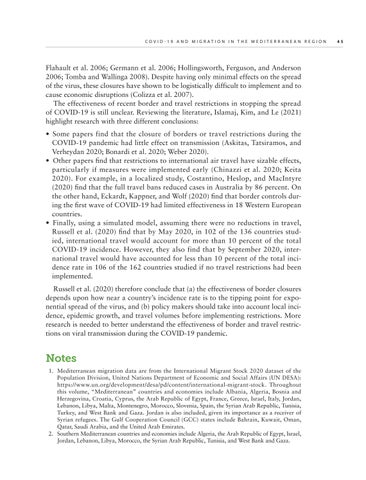C OVID - 1 9 a n d M i g r a t i o n i n t h e M e d i t e r r a n e a n R e g i o n
Flahault et al. 2006; Germann et al. 2006; Hollingsworth, Ferguson, and Anderson 2006; Tomba and Wallinga 2008). Despite having only minimal effects on the spread of the virus, these closures have shown to be logistically difficult to implement and to cause economic disruptions (Colizza et al. 2007). The effectiveness of recent border and travel restrictions in stopping the spread of COVID-19 is still unclear. Reviewing the literature, Islamaj, Kim, and Le (2021) highlight research with three different conclusions: • Some papers find that the closure of borders or travel restrictions during the COVID-19 pandemic had little effect on transmission (Askitas, Tatsiramos, and Verheydan 2020; Bonardi et al. 2020; Weber 2020). • Other papers find that restrictions to international air travel have sizable effects, particularly if measures were implemented early (Chinazzi et al. 2020; Keita 2020). For example, in a localized study, Costantino, Heslop, and MacIntyre (2020) find that the full travel bans reduced cases in Australia by 86 percent. On the other hand, Eckardt, Kappner, and Wolf (2020) find that border controls during the first wave of COVID-19 had limited effectiveness in 18 Western European countries. • Finally, using a simulated model, assuming there were no reductions in travel, Russell et al. (2020) find that by May 2020, in 102 of the 136 countries studied, international travel would account for more than 10 percent of the total COVID-19 incidence. However, they also find that by September 2020, international travel would have accounted for less than 10 percent of the total incidence rate in 106 of the 162 countries studied if no travel restrictions had been implemented. Russell et al. (2020) therefore conclude that (a) the effectiveness of border closures depends upon how near a country’s incidence rate is to the tipping point for exponential spread of the virus, and (b) policy makers should take into account local incidence, epidemic growth, and travel volumes before implementing restrictions. More research is needed to better understand the effectiveness of border and travel restrictions on viral transmission during the COVID-19 pandemic.
Notes 1. Mediterranean migration data are from the International Migrant Stock 2020 dataset of the Population Division, United Nations Department of Economic and Social Affairs (UN DESA): https://www.un.org/development/desa/pd/content/international-migrant-stock. Throughout this volume, “Mediterranean” countries and economies include Albania, Algeria, Bosnia and Herzegovina, Croatia, Cyprus, the Arab Republic of Egypt, France, Greece, Israel, Italy, Jordan, Lebanon, Libya, Malta, Montenegro, Morocco, Slovenia, Spain, the Syrian Arab Republic, Tunisia, Turkey, and West Bank and Gaza. Jordan is also included, given its importance as a receiver of Syrian refugees. The Gulf Cooperation Council (GCC) states include Bahrain, Kuwait, Oman, Qatar, Saudi Arabia, and the United Arab Emirates. 2. Southern Mediterranean countries and economies include Algeria, the Arab Republic of Egypt, Israel, Jordan, Lebanon, Libya, Morocco, the Syrian Arab Republic, Tunisia, and West Bank and Gaza.
4 5

